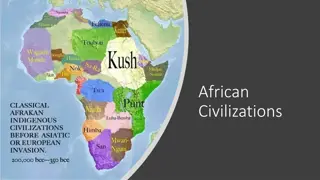Global Civilizations and Major Developments Throughout History
Explore the evolution of human societies from the Neolithic Revolution to the Classical Civilizations and beyond. Discover the major developments, continuities, and significant civilizations that shaped the world between 8000 B.C.E and 600 C.E. Uncover the beginnings of agriculture, Bronze Age, and the Iron Age, witnessing the rise and fall of empires and the emergence of ancient belief systems.
Download Presentation

Please find below an Image/Link to download the presentation.
The content on the website is provided AS IS for your information and personal use only. It may not be sold, licensed, or shared on other websites without obtaining consent from the author.If you encounter any issues during the download, it is possible that the publisher has removed the file from their server.
You are allowed to download the files provided on this website for personal or commercial use, subject to the condition that they are used lawfully. All files are the property of their respective owners.
The content on the website is provided AS IS for your information and personal use only. It may not be sold, licensed, or shared on other websites without obtaining consent from the author.
E N D
Presentation Transcript
8000 B.C.E. 600 C.E. Major Developments Neolithic Revolution / Development of Agricultural societies Changes in gender relations due to Neolithic Rev. Development of major belief systems (all EXCEPT Islam) Major migrations (Bantu, Huns, Germans, Polynesians) Early Civilizations Mesopotamia, Egypt, Indus, Shang, Olmec, Chavin Classical Civilizations (600 B.C.E. 600 C.E.) China, India, Mediterranean, Mesoamerica Collapse of Classical Empires Han China, Western Rome, Gupta India
Continuities 8000 B.C.E. 600 C.E. Gatherer-Hunter Societies Nomadic Societies
Major Civilizations 8000 B.C.E. 600 B.C.E. Mesopotamia Tigris and Euphrates Rivers Egypt - Nile River Indus Valley (Harrapan) - Indus River Shang - Huang He/Yellow River Mesoamerica: (Olmec No River!) Andean South America: (Chavin No River!)
Major Civilizations 600 B.C.E. 600 C.E. China: Han India: Gupta Mediterranean: Greek and Roman Mesoamerica: Olmec
8000 B.C.E. Beginnings of Agriculture
3000 B.C.E. Beginnings of Bronze Age Beginnings of Early Civilizations
1300 B.C.E. Iron Age
6thCentury B.C.E. Beginnings of . Confucianism (Confucius) Buddhism (Siddhartha Guatama The Buddha) Taoism (Lao Tsu)
5thCentury B.C.E Greek Golden Age
323 B.C.E. Alexander the Great
221 B.C.E. Qin unified China
32 C.E. Beginnings of Christianity
180 C.E. End of Pax Romana
220 C.E. End of Han China
333 C.E. Roman capital moved to Constantinople
4thCentury Beginnings of Trans-Saharan Trade Routes
476 C.E. Fall of Rome
527 C.E. Justinian Rule of Byzantine Empire
Nomadic, small communities and population, economic distribution is more equal
Live with husbands family Trace through father s lineage
Farming system where animals are taken to different locations in order to find fresh pastures























